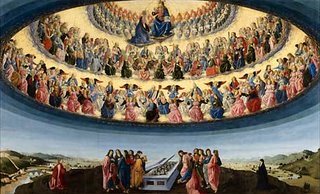Today on August 15th we celebrate the Assumption of the Blessed Virgin Mary, where we profess our belief in the Dogma that Mary was assumed into Heaven body and soul by the power of God. This is a Dogma of the faith and must be believed to be Catholic; it has been taught since the early Church to the present day with allusions in the Sacred Scriptures.
The Assumption has been believed and celebrated since the earliest times of Christianity. Today's feast was celebrated under various names (Commemoration, Dormition, Passing, Assumption) from at least the fifth or sixth century. Homilies concerning the Assumption go back to at least the Sixth Century. However, in order to make it a dogma of the faith meaning all Catholics must believe it, Pope Pius XII dogmatically declared Mary's Assumption into Heaven in 1950:
"... by the authority of our Lord Jesus Christ, of the Blessed Apostles Peter and Paul, and by our own authority, we pronounce, declare, and define it to be a divinely revealed dogma: that the Immaculate Mother of God, the ever Virgin Mary, having completed the course of her earthly life, was assumed body and soul into heavenly glory" (Munificentissimus Deus)
The Eastern Churches (which are still in union with Rome) refer to today as the Dormition as opposed to the Assumption because they believe that Mary died and was then assumed into Heaven. As Roman Catholics in the Latin Rite, we are free to believe that Mary died and then was assumed into Heaven or that she didn't die but right before her death she was assumed into Heaven.
Some claim that the Assumption never happened because it is not in the Scriptures, but remember that the Bible deals with God, not Mary. The Bible does not deal with the earthy end of any of the original disciples after the Gospel ends.
Remember, today is a Holy Day of Obligation, meaning all Catholics must attend Mass.
“It was fitting that she, who had kept her virginity intact in childbirth, should keep her own body free from all corruption even after death. It was fitting that she, who had carried the Creator as a child at her breast, should dwell in the divine tabernacles. It was fitting that the spouse, whom the Father had taken to himself, should live in the divine mansions. It was fitting that she, who had seen her Son upon the cross and who had thereby received into her heart the sword of sorrow which she had escaped in the act of giving birth to him, should look upon him as he sits with the Father. It was fitting that God’s Mother should possess what belongs to her Son, and that she should be honored by every creature as the Mother and as the handmaid of God” (Encomium in Dormitionem Dei Genetricis Semperque Virginis Mariae, Hom. II, n. 14; cf. also ibid, n. 3.).
Purgatory:
Please pray for the Souls in Purgatory today. It is written that at the time of Mary’s Assumption, all of purgatory was emptied, and the souls detained there accompanied her in her triumphant entry into Heaven. St. Bernardine of Siena also states that through her prayers and the application of her own merits, the Virgin has the power of freeing souls, especially her devotees, from purgatory. St. Peter Damian attests that every year on the Feast of the Assumption (August 15), the Virgin liberates thousands of souls.
Scripture:
"God’s temple in heaven was opened, and the ark of his covenant could be seen in the temple. A great sign appeared in the sky, a woman clothed with the sun, with the moon under her feet, and on her head a crown of twelve stars. She was with child and wailed aloud in pain as she labored to give birth.
"Then another sign appeared in the sky; it was a huge red dragon, with seven heads and ten horns, and on its heads were seven diadems. Its tail swept away a third of the stars in the sky and hurled them down to the earth. Then the dragon stood before the woman about to give birth, to devour her child when she gave birth. She gave birth to a son, a male child, destined to rule all the nations with an iron rod. Her child was caught up to God and his throne. The woman herself fled into the desert where she had a place prepared by God."
Revelations 11:19 and Revelations 12:1-6
Deiparae Virginis Mariae:
Novena:
Prayer Source: 1962 Roman Catholic Daily Missal
Learn More:
If you are interested in learning more about the Assumption of the Blessed Virgin Mary please consider purchasing the applicable lesson from CatechismClass.com, which is available for only a few dollars.






.jpg)

















